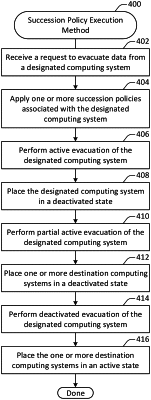| CPC G06F 16/214 (2019.01) [G06F 16/2365 (2019.01); G06F 16/2379 (2019.01)] | 17 Claims |

|
1. A method comprising:
receiving a request to evacuate data from a database system associated with a designated computing pod providing on-demand computing services to a plurality of entities via the internet, the data including a plurality of data portions, one or more of the data portions corresponding with a respective one or more of the on-demand computing services;
identifying a plurality of data succession policies associated with the data, the data succession policies corresponding with a respective one or more of the plurality of data portions and identifying one or more constraints associated with evacuating the respective one or more data portions;
transmitting the data portions to a respective recipient computing pod, a first subset of the data portions being transmitted in an active phase in which both the designated computing pod and the respective recipient computing pod continue to provide on-demand computing services related to the first subset of the data portions, a second subset of the data portions being transmitted in a deactivated phase in which neither the designated computing pod nor the respective recipient computing pod continue to provide on-demand computing services related to the second subset of the data portion, and a third subset of the data portions being transmitted in a partial active phase in which the designated computing pod no longer provides on-demand computing services related to the third subset of the data portions and in which the respective recipient computing pod continues to provide on-demand computing services related to the third subset of the data portions, the first, second, and third subsets being selected based on the plurality of data succession policies; and
removing the data from the database system.
|